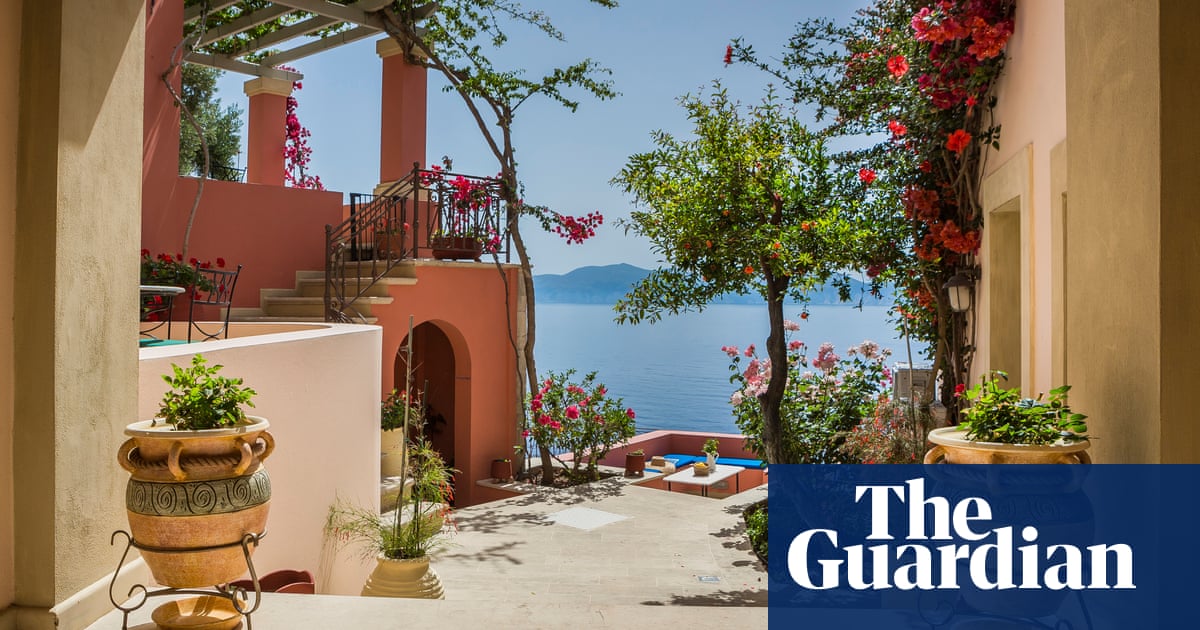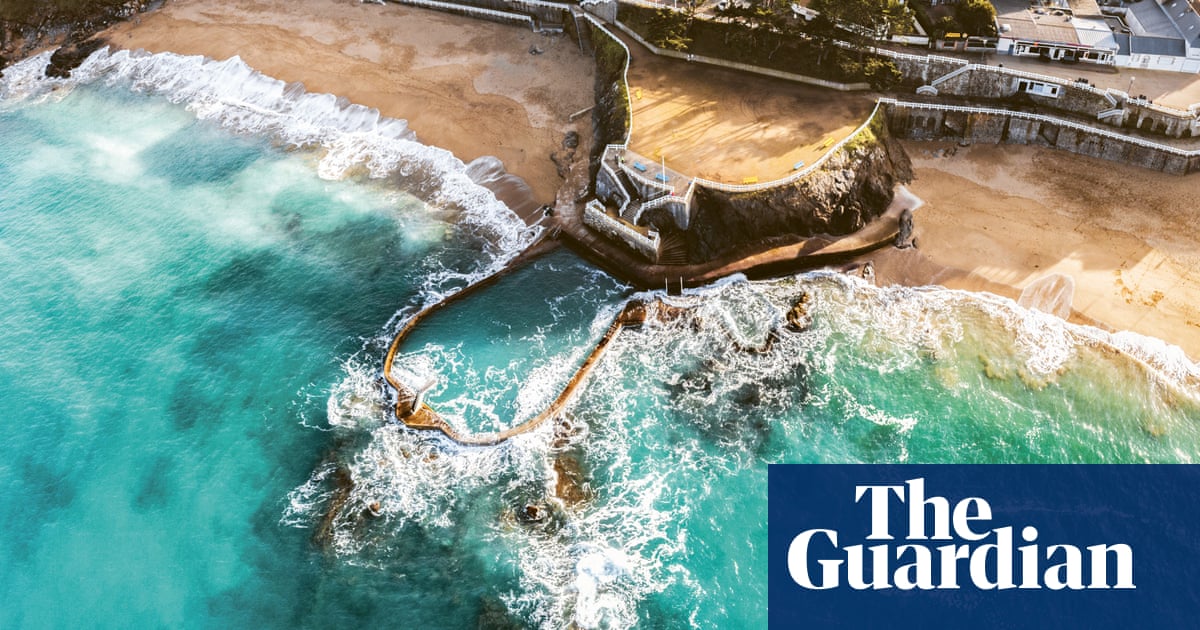
Assos, Cephalonia, Greece
There’s something quite particular about small but perfectly formed Assos – butterscotch and rose-pink houses line a horseshoe bay, with Venetian ruins scattered between the narrow alleys. There are two small beaches, but the real joy is to rent a motor boat and discover the small bays and coves that fringe this part of the Cephalonian coast. Walkers can follow the path out on to the headland to the ruins of Assos’s 16th-century castle; there’s not a huge amount to see, but the views make the walk worth it. Roi Suites is a bougainvillaea-clad cluster of well-equipped studio flats in a waterfront neoclassical building, with gorgeous sea views from the pool terrace.
Doubles from £117 (minimum seven nights), roisuites.com
Akyaka, Turkey
One of Turkey’s “cittaslows” – slow towns, with an emphasis on nature and sustainability – Akyaka sits at the mouth of the Azmak River on the shimmering Bay of Gökova. Behind the beach, a lattice of bougainvillaea-clad streets is home to traditional lokantas (simple bistros) and cafes; at night the seafront restaurants set tables on the sand. Boats potter up the Azmak from the small harbour, where fish restaurants line the leafy riverbank and a shady walking trail leads into the countryside. Akyaka is also Turkey’s kite-surfing hub, with several surfing schools on the long stretch of beach just out of town. The Iskelem, set in a tranquil bay over the headland, is a gloriously peaceful retreat with simple rooms and an excellent restaurant.
Doubles from £83 B&B, iskelemotel.com.tr
Göltürkbükü, Turkey
If Turkey has a Saint-Tropez, this glitzy coming-together of two villages, Gölköy and Türkbükü, is it, with a newly created public beach and decked beach clubs that ooze a chilled, Côte d’Azur vibe. There’s plenty going on but it’s still far quieter than nearby Bodrum, and has a particularly strong restaurant scene – book a table at Arnavutköy for a sumptuous, fish-themed splurge. Behind the beach, souvenir shops stand cheek-by-jowl with designer boutiques, small pensions beside five-star hotels, and the regular dolmuş (public bus) offers the chance to explore other villages on the peninsula, including unspoilt Gümüşlük, with ramshackle fish restaurants along the beach. The Matiz is a friendly B&B with five simple rooms, a tranquil leafy garden and roof terrace.
Doubles from £86 B&B, matizturkbuku.com
Šibenik, Croatia
To say Šibenik is a mini-Dubrovnik may be slightly overstating the case, but it has the same elegant Venetian architecture and terracotta-roofed houses – and considerably less in the way of crowds. This is a town built for wandering: from the Riva, the seaside promenade, up to the elegant cathedral and through the tangle of passageways and alleys that lead up to the 11th-century St Michael’s Fortress. Blue-flagged Banj beach is a 200-metre walk from the centre, and has a restaurant and play area, while boat trips run out into the unspoilt waters of the Kornati archipelago. Hotel Life Palace is a lovingly renovated 15th-century mansion, with 17 rooms that channel the historic feel, with frescoes, exposed brickwork and Renaissance-inspired furniture.
Doubles from £118 B&B, hotel-lifepalace.hr
Cavtat, Croatia
One of Dalmatia’s most charming small seaside towns, Cavtat has terracotta-roofed houses that ripple out around a small horseshoe bay, with two wooded peninsulas stretching out towards Dubrovnik, 13 miles away across the water. Low-key cafes and restaurants – several run by the same families for decades – run parallel to the waterfront promenade, with swimming platforms and small pebble coves giving way to crystal-clear water. Boat taxis run regularly to Dubrovnik and nearby Elaphiti islands, and there’s a lovely circular walking route through the woods, with a couple of simple beach bars that are perfect sundowner spots. Villa Pattiera, once the home of opera singer Tino Pattiera, stands at the top of the promenade, with lovely views from its 12 apricot-hued bedrooms.
Doubles from £156 B&B, villa-pattiera.hr
Santa Maria di Castellabate, Campania, Italy
A world away from the hustle of the nearby Amalfi coast, the Cilento coast is studded with small seaside towns where faded palazzos and fishers’ houses overlook unspoilt beaches. Santa Maria is just such a place: fishing boats return early in the morning to supply the town’s restaurants, with fishers mending their nets on the blue flag beaches. Days can be spent lazing on the sands or following hiking trails into the Cilento national park, with the nearby archaeological sites of Paestum and Velia a big draw for history buffs. Stay at the Hotel Garden Riviera, on a hillside 500 metres from the centre, with gorgeous sea views and a shuttle to the beach. Doubles from £72 B&B, hotelgardenriviera.it
La Flotte en Ré, Île de Ré, France
Once an important sea-fishing port, La Flotte is one of the Île de Ré’s most beautiful villages, with a tangle of lanes and alleyways running between classic Breton-style houses, a waterfront lined with restaurants and a sizable marina. Nearby Arnérault beach is the best choice for a lazy afternoon; the trees behind the beach offer shady spots for a snooze, with changing and toilet facilities – although it is very tidal, so check times before setting off. There are bikes to hire for the ride to atmospheric Abbaye des Châteliers, and a daily morning market for picnic goodies – excellent cheeses, breads and cured meats. The Hôtel Hippocampe is in the old village, with chic, airy rooms.
Doubles from £74 room-only, hotel-hippocampe.com
Concarneau, Brittany, France
Steeped in history, with a belter of a beach and a working fishing fleet that fills the town’s restaurants with the freshest seafood, Concarneau is Brittany at its breezy, beautiful best. A town of two parts, it has 14th-century ramparts around the old town, set on a small island, and cobbled streets that wind between the houses to the bustling fishing port. Plage des Sables Blancs – a long stretch of unspoilt sand – is a short stroll from the centre of town, with good facilities including lifeguards. The Fishing Museum and the Marinarium – the oldest marine station in the world – are good wet-weather options for families. The Hotel Ker Mor is a quirky 19th-century hotel by the water’s edge.
Doubles from £117 B&B, hotel-logishotels.com
Fornells, Menorca, Spain
Not to be confused with Playa de Fornells – a newer development a few miles away – Fornells is one of Menorca’s most charming fishing villages, with a low-key waterfront dotted with palm trees that has become a fish restaurant hub (the dish to order is caldereta de llagosta – lobster stew). In recent years it has also become known for watersports, with reliable winds making ideal conditions for windsurfing and wing-foiling; there are paddleboards for calmer days. The town beach is small, but Cala Tirant, on the other side of the headland, offers clear waters and a wide stretch of sand. Can Digus has light, airy apartments in the heart of town.
Doubles from £57 room-only (two nights minimum), candigus.com
Llafranc, Girona, Spain
The jumble of whitewashed houses, blue doors and small fishing boats bobbing in the water give Llafranc a pleasingly old-school feel. Once the Costa Brava’s most glamorous spot – attracting everyone from Ernest Hemingway and Salvador Dalí to Elizabeth Taylor and Sophia Loren – it has mellowed into a quiet, family-friendly resort that only really gets busy in July and August. The sheltered harbour is ideal for watersports, including kayaking, sailing, scuba-diving and paddleboarding, and there are good walks – particularly the mile-long stroll around the pine-clad headland to Calella de Palafrugell – and enough bars to create a bit of night-time buzz. Hostal Sa Teula sits 100 metres from the sea, with 18 unfussy bedrooms and a restaurant serving locally caught fish and classic Catalan dishes.












